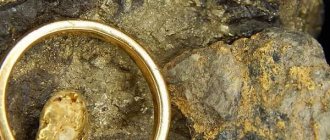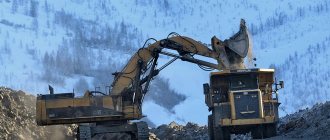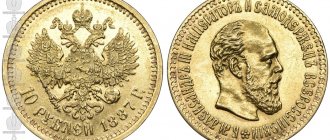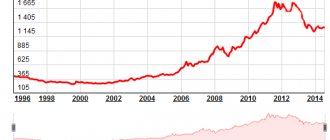Finding gold is hard work. Sometimes months of fruitless efforts and research pass in search. Russia is far from being the last among the countries that have deposits of this precious metal. Moreover, in recent years it has ranked 5th among gold-mining countries. Geologists advise looking for precious metal only where it can be found, and for this there are a large number of ways to find metal in the form of flakes, nuggets, gold sand and placer gold. Precious metal may be found in areas where mining companies have operated.
It can be on the surface layer, in the middle of mountain streams or on a raft, in bedrock, or rock cracks. But you shouldn’t look where searches have never been carried out; the likelihood of finding precious metal there is almost zero. When a person finds even a small pebble of gold, he understands that his labors were not in vain, so he should not be discouraged. Great luck, geological knowledge and a good tool will increase the likelihood of a find many times over.
Basic signs of gold
It is very easy to confuse gold with another mineral if you do not know some of its features. Everyone knows that it is yellow and shiny. But, besides gold, pyrite and chalcopyrite have such characteristics. Nuggets can be yellow with red and greenish hues.
The natural material is malleable and can be forged. It does not oxidize, but dissolves in hydrochloric or nitric acids. If you look for gold in ores, you first need to focus on the fact that the metal grows together with other minerals. It will not clearly crystallize like pyrite and chalcopyrite. The noble metal is often found fused with quartz, appearing like a grain or plate.
Alluvial gold is characterized by grains in the form of hooks or wires. In this form, natural material is found in the form of small grains and various kinds of nuggets. If we consider its dimensions, we can distinguish the following categories:
- finely dispersed (up to 10 microns);
- visible (0.01-4 mm);
- nuggets (from 5 g to 10 kg).
To distinguish it from pyrite and chalcopyrite, you need to pay attention to the color. The pebble is viewed from different angles. From any angle, gold will not change its original shade. Pyrite will give itself away by changing its color. Its bright yellow color will fade to gray upon inspection. Gold can be checked with a knife; it will not crumble like pyrite and chalcopyrite, but it will leave grooves or lines on it.
If doubts have not been dispelled after the procedures, you can test the metal using sulfuric acid. Gold's color will not change, but pyrite and chalcopyrite will change it. Pyrite in areas of impact will turn black, and chalcopyrite will turn red.
What does gold look like and where is it found in nature?
The value of this metal is due to the difficulty of mining: it is difficult to find, and even more difficult to extract. The bulk is in a sprayed state and distributed throughout the planet; it can even be detected in people (about 10 mg). In the waters of the World Ocean there are approximately 9 billion tons of aurum (about 6 mg per ton).
The presence of gold in the rock is modest compared to previous indicators - only 0.25 g/t. However, humanity has not yet figured out how to effectively extract the atomized metal, and therefore about 0.00002% of all reserves in the form of grains and nuggets are subject to extraction.
Au, which can be found in nature, has a dull luster, yellow color interspersed with impurities. Pure nuggets are not found.
Precious metal deposits
There are many places where you can find gold. But to a greater extent, gold ores are formed in mountainous and watery places. Near the mountains, in depressions, young gold deposits are found. Gold veins accumulate in places of faults and cracks in mountains, rocks, and are located along the line of mountain rivers. They come from the bowels of the earth through special channels (fault zones and igneous rock dikes). The total length of such veins can reach several hundred meters, and sometimes reach up to 2 km.
In search of gold, prospectors find pure deposits of gold veins and complex places of formation of non-ferrous metals. In the second case, placer deposits of gold are formed due to the properties of the precious metal to dissolve and oxidize under natural conditions. Gold can come into contact with other minerals and form where sulfides and granitoids come into contact with limestone. Vein deposits are located at different depths, so they are divided into 3 categories:
- low temperature;
- medium temperature;
- high temperature.
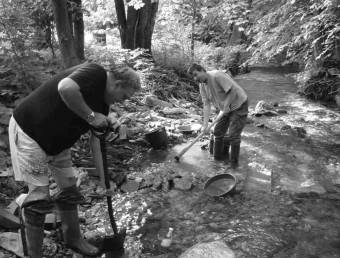
The precious metal is sometimes an integral part of the gold-polymetallic zone, then silver, zinc and lead are combined with it. In Cretaceous sedimentary formations, in depressions and conglomerates, gold-bearing veins are found in places of faults and large cracks. In these zones, the metal is found in generations with different types of quartz, sulfides and other minerals. But the largest areas for extracting priceless metal are stockwork areas. Gold, along with sulfides and quartz, is scattered in areas of large cracks in the form of inclusions or veins in the rock. Such deposits can be very long and large. Therefore, in such zones, metal mining is organized industrially, where ordinary miners can search for gold quite effectively after completing all the work.
Types of metal deposits
The most common gold deposits are quartz veins, created by nature over many years. Over time, these veins were destroyed by external factors, and both quartz and gold were washed away by sediments into rivers. At the bottom there was a constant movement of stones, which crushed and rolled around the metal. Due to the fact that the noble metal is heavier than other minerals, it was deposited in certain areas of the ducts. With just one glance at the size and degree of rounding of a sample, specialists can determine its travel history and the location of the main vein.
You can successfully search for gold near a river only if the map contains marks on the main places of deposits, which can be both at the bottom of the river and near it. Near the river there are residual deposits formed due to the weathering of the vein. Some pieces of vein and nuggets moved a certain distance from the main location, but did not fall into the pond. These formations are called eluvial. When looking for terraced metal deposits, you can find formations above the water level (old bottom) and at a great distance from the current riverbed, sometimes they are found even high in the mountains. The last place where gold is formed is the bottom of the river, where the metal was washed away by water from the main vein.
Gold is several times heavier than other minerals, so its movement along the bottom occurs only under the strong influence of water masses over short distances. The movement occurs in the area of the river that is between the bends. Large stones become an obstacle to gold, so it is better to look for gold under them at the bottom of the river. As the river widens, the flow speed decreases, so gold can settle in such areas.
Types of deposits
Territories where gold lies on a scale sufficient for industrial mining are rare. Such places are called deposits. Also, a small amount of Au is found in deposits, placers, and ores.
Bedrock or ore deposits
Primary (primary, ore) accumulations appear in the mountains:
- In the deep layers of the planet, under the influence of high temperatures and strong pressure, the combination of chemical elements forms solutions of gold and quartz.
- Then the hot compounds move upward along cracks in the crust.
- Closer to the atmosphere, temperature and pressure drop, the shape of the aurum is destroyed, and the quartz crystallizes.
- The output is ore interspersed with gold. As a result of temperature changes, weathering, precipitation, and the actions of microorganisms and plants, the metal is gradually released.
Colluvial placer
Occurs on the surface during the destruction of primary gold deposits. It is also called secondary and is considered the least profitable for extraction.
Eluvial deposits
It is transported by water flows along river beds, and since aurum is one of the densest and heaviest metals, the metal settles and accumulates in suitable places. Placer gold can be found in the watersheds of major waterways in the form of debris and sand.
Residual deposits
These are Au grains formed as a result of weathering of a gold-bearing vein and located in close proximity to it.
Bottom sediments
The bottom of reservoirs consists of sedimentary formations - stones, sand, gravel, clay, lying on bedrock. As these materials are washed away from rocky terrain by large rainfall streams, depressions are formed in the riverbeds. Over time, the precious metal enters the water and settles in a pocket along with other masses, accumulates and creates bottom deposits.
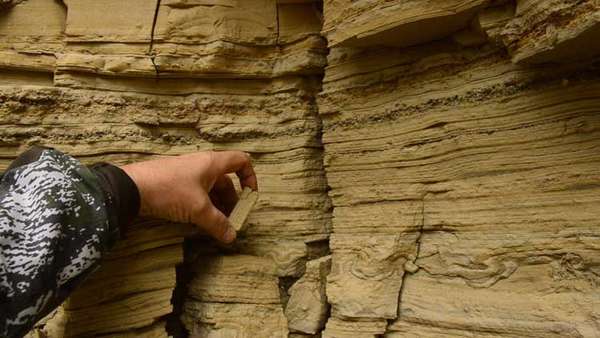
Terrace deposits
Sometimes a river, having cut through the ground, goes down, and the old bottom remains above the water level. This is called a terrace. It can be directly above the channel or located at a distance from it. The deposits remain on it.
Gold content of quartz
Quartz is the most common mineral and forms in veins with many metals and minerals. In the search for the noble yellow metal, it plays a major role because the appearance of quartz can reveal the location of the gold. To correctly read quartz, knowledge of the properties of the gold-bearing sample is necessary. This mineral comes in a variety of colors and shades; it can be transparent, black, white, or gray. You can search for gold in quartz in several types:
- corn;
- nest;
- veins;
- germination;
- invisible dispersive.
If ore minerals were in quartz, but were leached, then the quartz has signs of sponginess. When the process of sulfide decomposition occurs in a gold-bearing vein, quartz crystals acquire yellow, cherry-red, or shades similar to them, which indicate that the mineral is fermented. If a prospector in search of yellow metal sees banded quartz with powdery layers or with the inclusion of tourmaline and sulfides, it means that representatives of low-temperature or high-temperature layers are somewhere nearby. Such zones may contain gold.
Yellow metal satellites
Some prospectors, in search of wealth, focus on the companions of gold, and there are many of them. Quartz, adularia, silver, pyrite, galena, platinum - all these minerals are found with gold. The only problem is that the presence of one of the gold satellites in the ore does not always indicate the presence of a noble metal in it. Sometimes gold ores consist of fused quartz, lead and gold, sometimes gold, quartz and antimony, and sometimes a combination of gold, silver, quartz and feldspars.
Even about silver, the most common neighbor of gold, it cannot be said that it always indicates the presence of the yellow metal in ores. But when a nugget is found while searching, it is almost always mixed with silver. In some cases, the share of silver reaches significant figures, but sometimes this part is negligible. The ideal ratio of gold and silver in ores occurs mainly in volcanic zones. They can be in Kamchatka or any other Far Eastern region.
Native gold
The field of examination of native gold has advanced further than others today. In deposits, yellow metal can be present in three main forms:
- submicron impurities dispersed in sulfide minerals;
- bound metal in the form of compounds such as antimonide, telluride, sulfide or selenide;
- native gold in the form of free deposits.
The forms of yellow metal release can be very diverse:
- veins, plates and scales;
- sponges or lumps;
- branched structures;
- crystalline forms;
- drusenoid;
- dendritic;
- wire;
- needle-shaped;
- angular;
- teardrop-shaped.
Their common difference is the predominance of irregular outlines for large formations and ordered forms for small ones. The dependence of the shape on the depth of the samples is also observed. Thus, at a small depth from the surface, elongated structures, sometimes hair-like or even flat in shape, predominate.
Native gold may contain impurities of silver, mercury, copper, palladium, antimony, cadmium and even platinum. These elements form uniform intermetallic compounds or solid solutions with the yellow metal. If mechanical impurities are present in a precious metal, their distribution throughout the volume will be uneven. For example, in the Yakut deposits of gold and bismuth, the rare mineral maldonite is constantly present, containing gold metal mixed with bismuth and bismuth telluride.
The Central Research Institute for Geological Exploration of Precious and Non-Ferrous Metals has created a Russian multi-stage methodology for fingerprint examination of gold . Today it is used not only by geologists, but also by criminologists, since investigators often need to identify a deposit of native gold that is in illegal circulation. Such identification helps to identify and shut down sources of theft and transportation routes for precious metals, as well as detain criminals.
In the last few years, gold forensic technology has improved significantly. Previously used methods no longer met modern requirements and did not allow obtaining a reliable evidence base. To improve, it was necessary to study more deeply the geochemistry of native gold and introduce precision research techniques into the system using such analyzing instruments as scanning electron microscopes, X-ray spectroscopes for microanalysis, electronic, emission, optical and inductively coupled plasma spectrometers. This arsenal of modern equipment provides fundamentally new opportunities for obtaining information about gold samples from various places in Russia and creating full-fledged geochemical models of native gold.
The use of improved fingerprinting methods for native gold makes it possible to obtain qualitatively new data about the precious metal, such as establishing its origin, regardless of size and level
primary enrichment of the sample. The technique made it possible to create a database of information on gold mining sites in eleven Russian regions. It contains quantitative and qualitative characteristics of the precious metal from each specific deposit, obtained on the basis of geochemical and X-ray spectral studies.
Each new examination contributes to the expansion and replenishment of the database. On its basis, a special search system for the necessary information has been built, which allows you to find analogues and create queries for each individual characteristic of gold. By refining the search criteria, the list of objects is reduced to one or several with characteristics similar to the sample under study.
First, using a set of parameters of surface relief, morphology, presence of impurities, fineness and granulometry, the ore region and metallogenic zone are determined. If data on one of the characteristics is missing, the results of the examination may be ambiguous.
To clarify the conclusions, in conclusion, information on intergrowths with other substances, the composition of surface films, the internal structure and morphogenetic variety of native gold is analyzed. This way the deposit is determined more accurately.
In the case of examination of native gold that has previously been subjected to artificial sampling, mechanical deformation or amalgamation, the preserved characteristics are used to identify the sample. The reliability of the conclusions obtained in this case may be lower.
Increasing the reliability of gold examination results is possible if we apply the mass spectrometry method using inductively coupled plasma, which allows us to obtain accurate data on the presence of certain impurities. Based on the analysis of the results obtained by this method, calculations were made of the geochemical characteristics used as criteria for determining the regions of origin of native gold.
Analysis of the structure and composition of the thinnest surface films of samples with the identification of micron and submicron inclusions of minerals is carried out using X-ray spectroscopes, electron microscopes and Auger spectroscopes. The information obtained makes it possible to see the differences between gold mined in different ore formations, gold-bearing provinces and even individual deposits.
Rich places in Russia
Russia is rich in different types of deposits, so you can search for gold in almost all its regions. Skarn, hydrothermal deposits and gold-quartz formations are scattered in different regions of the Russian Federation. Approximate list of areas and types of gold deposits:
- Siberia (Olkhovskoe) - skarn type;
- Ural (Berezovskoye), Transbaikalia (Darasunskoye) - gold-quartz-sulfide formation;
- Pacific ore belt - volcanogenic hydrothermal deposits;
- Transbaikalia (Baleyskoe, Taseevskoe) - gold-quartz-chalcedony-sulfide formation;
- Northeast Russia (Karamkenskoye) - gold-silver-quartz-adularia formation;
- Yakutia, Magadan, Transbaikalia, eastern Siberia - alluvial placers;
- Chukotka, Ural, Magadan, Bodaibo, Amur and Taximo are golden nuggets.
Many geologists are constantly in search of minerals; they skillfully use geological knowledge and can find gold even in places where an industrial base has been operating for many years, and then also miners. Where, it would seem, everything has already been dug up and dug up, people have almost reached the magma, but still 50 g or 100 g of gold can be found.
Sanarka
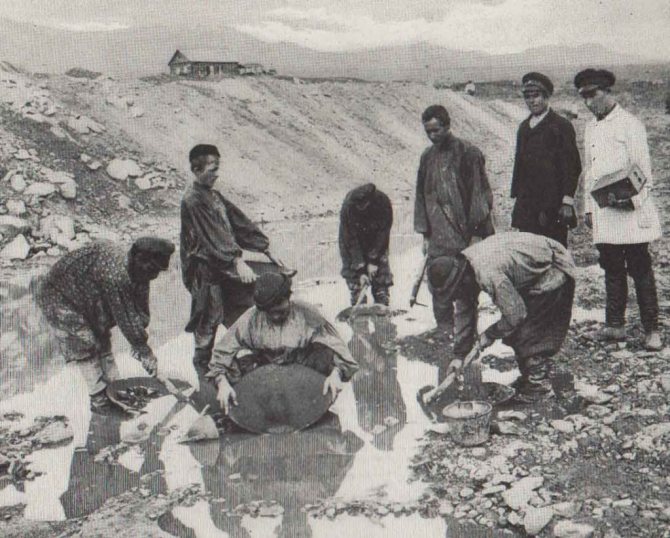
Sanarka belongs to the basin of the Kazakhstan Tobol River. It is located in the Chelyabinsk region, and rumors about it spread throughout the country due to the huge gold reserves that were discovered by the famous academician Nikolai Koksharov. He was the first to call the river basin “Russian Brazil” in his research works. His works contributed to the organization of industrial gold mining in Sanarka. Today, almost all gold reserves there have dried up, and further mining has been declared unprofitable. However, if you mine gold yourself, you can make good money. Although it is almost impossible to work alone, some craftsmen who devote a lot of time and money to preparation succeed.
Teeth Whitening Powder: I've been using this simple recipe for years.
To see seal pups, you need to go to Canada in winter (video)
Clear out the pantry: 6 things you can do in a day
How to choose a place?
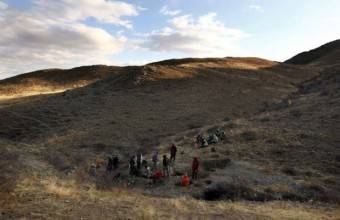
It is necessary to examine the geological composition of the area: what fossils were found, their location and search method. Gold in Russia is found in different forms, but if there are gold placers in the surveyed area, then the place is suitable for survey. This can be either an industrial area or a non-industrial area. It should be noted those areas where industrial bases have worked or where quartz is present in this area. It is necessary to consider the valleys that form the tributary of the river. The valley is divided into 3 parts: upper, middle and lower. It can be noted with greater confidence that gold will have to be looked for in the upper part of the valley, but there have been cases when gold-bearing places were located both in its middle and lower parts.
It is easier to search for gold based on the characteristics of the deposit when the bedrock is not under sediments and sediments. For example, quartz gold-bearing veins appear as ridges and ridges on the surface of the surveyed area. Quartz can also be in the form of placers, blocks and fragments of a characteristic white or brown-red color. If you look for gold in elongated depressions or clearly defined troughs, you can find stockwork ore deposits. When conducting a survey of a steppe area, the search for gold should be carried out in a place where there are the most thickets, or in a place where there are the least amount of them.
Bodaibo
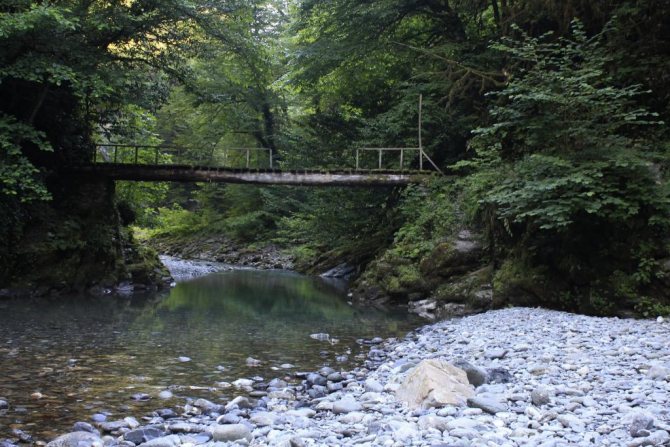
One of the richest deposits in Russia is located in the basin of this river in the Irkutsk region. Bodaibo can be attributed to the Lena gold-bearing region, if you look at it from a geographical point of view. Over one hundred and fifty years, gold miners managed to extract more than 600 tons of gold. Today, active work continues in the Bodaibo basin. Many experienced workers say that this place is surprising because of the presence of a large number of large nuggets and grains of gold sand.
A complete hassle: which zodiac signs will quarrel with their relatives in 2021
Nut cake: delicate sponge cake, chocolate and just a lot of nuts
Moscow has become the leader in traffic jams: 2021 study

That is why many people rush here to make money. In such a rich place, the likelihood that luck will not pass you by increases many times over.
Necessary tool
Attentiveness, geological knowledge and a metal detector can help in the search. This equipment is quite expensive and will quickly pay for itself, but not all models will cope with the task. Moreover, you need to know how to use and set up a metal detector, since it is very sensitive to the soil, which itself will create interference. The metal detector detects large nuggets at shallow depths (up to 1 m), and the smallest ones at a depth of up to 15 cm.
A special feature of working with such products is its excessive sensitivity, which is caused by a large amount of minerals and iron in the soil. The device should not be configured for a specific type of metal; it must be operated in the mode of detecting all metals without exception. Iron, like gold, produces the same sound, so it is better to stop and test the ground rather than continue searching for gold to no avail. It is necessary to listen to the soil using headphones, so you should be extremely attentive to changes in noise.
The number of false signals coming from the ground depends on the sensitivity level setting. When the sensitivity of the metal detector is low, a person hears deeper sounds of ground testing. The result of the work also depends on the ground balance setting. Ideally, the headphones will display background noise as the metal detector probes the soil, the sound may decrease or increase.
To adjust, you need to turn the knob responsible for ground balance. Every 5-7 m you will have to adjust this function, since the mineralization of the soil may be different. To search for large-sized gold on fairly strong mineralized soil, it is necessary to use a negative setting, which will reduce the sensitivity of the metal detector to small nuggets. And, conversely, when searching for small nuggets, the adjustment is made in a positive direction. The best tuning method is a small sample of gold or lead.
When listening to the soil, the metal detector coil should be kept as close to the surface as possible. When a signal occurs, listening is carried out in all directions from the possible location of the nugget. If gold is present, the signal will be heard in all directions, and if the signal is only triggered in a certain direction, then it is not gold. The last step of the test will be to raise the coil above the intended location. If the sound suddenly fades away, it means the signal is false, and this place does not even contain metal.
Tray - equipment for beginners
Washing trays are used for taking samples, but those miners who have not yet mastered all the intricacies of searching use the tray as a means of extracting gold.
Professionals work with a metal detector because up to 100 g of gold can be collected in a week of panning. But they are still used today. The choice of tray determines the efficiency and speed of work. It is inconvenient to look for gold with a metal tray. There are greasy hand marks on it; they can only be removed by annealing the tray. The metal is corrosive and cannot be tested with a metal detector or separated from magnetite and gold. All the negative aspects of a metal tray are completely absent from a plastic product, and a green tray is an ideal product in which gold flecks are very clearly visible.
In searches, trays with a diameter of 15-40 cm are used, but a tray with a diameter of 40 cm will weigh approximately 10 kg in use. Therefore, the best option would be a tray with a diameter of 35 cm. In addition to the trays, you need to purchase a plastic sieve (mesh size 12 mm). Rinse should be 300-500 m higher from the river mouth. A good sign would be if at least 1 piece of gold gets into the tray, but if nothing is found during washing, this is not a sign that the stream is hopeless. If there are large nuggets in it, then there will be very few small gold pieces.
Additional devices
A minidrag is a device that is used in underwater searches. In terms of operation, it resembles a regular vacuum cleaner, comes in different sizes and, accordingly, has different productivity. Small mini-dredges weighing 24 kg are capable of processing 100 kg of material per hour, and large devices weighing 90 kg can process 1000 kg/hour.
A minidrag consists of an engine, a pump, an injector, a flushing chute, a floating system on which all the equipment will be located and sometimes the air supply system will be turned on.
The minidrag sucks material from the river bottom into the injector, which then falls into a washing trough that separates the gold from other materials. Searching for gold in this way is not always easy or simple, because there are a large number of stones, boulders and other obstacles along the way.
The second device that is used in searching for precious metals is a gold probe. This is an electronic device that detects gold on soil and under water. It consists of a probe, at the end of which there is a sensor device, and a control unit is installed on the probe handle. They look for gold in the soil by sticking a probe into the ground, the sensor comes into contact with the metal and produces a certain signal, after which the light turns on. The magnetite probe reacts with a different sound tone and light bulb color. It catches those small gold particles that are inaccessible to a metal detector.
Extraction technologies
There are fewer deposits and they are being depleted. Therefore, the ability to separate gold from ore is especially valued. Here is a list of the best techniques:
- amalgamation,
- heap leaching,
- etching.
Methods for extracting gold from river beds
The sifting and washing method involves passing river sand through a sieve, tray or burlap by hand. Only Au particles larger than a grain of sand remain in the dish.
Mechanisms - dredgers, pumps, screens - dig the mass from the bottom, deliver it to the shore and quickly process it, sifting out the excess. At the same time, the amount of manual labor and the time spent on it are reduced.
Different search methods
It depends on the area how to look for gold and what method should be used. If the survey area is poorly studied by geologists, and the searches were not carried out in full, it is necessary to use the pebble method. The bed deposits of springs and small rivers are checked with a metal detector. These places are examined for the presence of quartz with traces of precious metal or for the obvious presence of gold. In tributaries of rivers and directly in streams, the survey is carried out from the bottom up: these are the places where quartz pebbles should be looked for and the results recorded on the map. If the metal deposit is close, the number and size of pebbles will increase.
Then the dump search method is used, when a group of prospectors combs the area in search of ore dumps and spills, which are carefully marked on the map. The distance between people should be about 70 m, if the area is densely populated - 15 m. If, while searching the rocks, prospectors come across fragments of quartz rock, then the circle of searches must be narrowed and boundaries set. Quartz samples are examined, and based on their characteristics, the location of the ore body is guessed. To confirm the hypothesis, reconnaissance should be carried out using the trench method.
If there are no ore dumps, then you look for gold using the digging method. The method allows you to search for a crushed vein by gold released to the surface. It will be located on elevations and sediments, so the search will involve several people who go through the digging lines and take sample material from them. The easiest way to take material for washing is from clay crushed stone, which is located under a layer of turf. A few kilograms of material, which is washed in an Asian ladle, is enough. After the material has been washed, it is examined through a magnifying glass and gold particles are looked for. Proper examination and diligence are a guarantee of a successful discovery.
Where to look for gold nuggets. Mountain streams. Story.
For our search, we chose the small stream Sredny, the right tributary of Kilyana, which is not far from Taksimo. The river abounds in small grayling and is squeezed on all sides by steep slopes of wooded hills. In the lower reaches of the river, until 56, prospectors little by little washed the gold sand. No mining was carried out higher, although we managed to find several pits and a trench overgrown with moss and lichen. The river, despite the fish, was of little interest to us, but it was interesting to find out where the golden sand came from. If there is gold in the lower reaches of the stream, it means it came from somewhere. Where? Maybe there is still a good nest left there? Worth looking.
From Kilyana, rising along a wide river valley to the upper reaches of the Sredniy stream, on the right side, there is another stream suitable in all respects for exploration. It is worth exploring it and all nearby streams with a length of 3-10 km, with a slope of 50-200 meters per kilometer. If the slope of the stream is small, then the bedrock is at great depth, hidden by waste rock and is of no interest to us. With a metal detector we will not be able to look deeper than half a meter. If the stream is short and its slope is very large, then it is unlikely to serve as a source of gold, since it is too young by geological standards.
The jeep slowly crawls straight along the winding pebble riverbed. We were surprised that the path indicated on the map bore a suspicious resemblance to the road made by a bulldozer several years ago. We did not yet know what awaited us ahead, but such easy progress did not bode well. Only occasionally the road was blocked by trees that had fallen during the spring flood. In three hours we covered approximately half of the planned route, and were quite surprised when we ran into the drilling line. That's it, we've arrived! It seems we got ahead of ourselves. The width of the valley in this place is 70 meters, to bedrock from 3 to 6.5 meters as indicated on the borehole markers. In the morning we will walk to the upper reaches of the stream in search of brushes.
The day turned out to be hot and I didn’t really want to put on rubber boots and incephalitis, but the midges left no chance for a tan. It was easy to walk along the riverbed, jumping from stone to stone, examining small rock outcrops along the way. In vain. Having walked about two kilometers, the valley narrowed to 10 meters, the stream dived somewhere under the stones, sandwiched by blocks of stones. It's time to go back, there's nothing to catch here. You can't get through with a metal detector. The mood is at zero, in the camp we silently chew buckwheat with condensed milk, washing it down with hot tea flavored with currant leaves. Theory is theory, but practice is a completely different matter. Looking at the drilling line posts, we wonder whether or not to go to the second stream, to the Sredniy itself. Okay, let's go downstairs, we'll see there.
The ascent to Sredny began with a wide road cut along a terrace along a stream. Why not ride with the breeze? Go. After 10 kilometers, a well-trodden road led us to an abandoned site. The entire valley has been bulldozed and resembles a gravel pit rather than a wild stream. There are pieces of iron all around, barrels, beams on wheels without one wall and a pile of boards. All this disgrace stretches for a good kilometer and ends in sections of 100 meters, ironed by a bulldozer to the very base of the cliff. Just what we needed, the miners left us a prepared site, removing all the alluvial loose deposits. And above are brushes untouched by the miner's team. Bad mood away, where are the metal detectors? We scattered around the training ground.
I slowly wander along the noisy stream, listening to the beeping of the metal detector. “Bik” is a slightly perceptible signal, but clear. Surely my Eureka Gold caught a nugget in a crack in a stone monolith several centimeters above the level of the seething stream. Using the sharp end of a geological hammer, I carefully widen and deepen the crack, removing its contents. I expect a nugget of at least a gram, but I am surprised to find gold smaller than a match head. There’s still something “beeping” in the crack, but I’m reluctant to bother with such a small thing, it’s getting dark. I cheerfully follow the trail of the bulldozer to the camp, clutching a piece of gold under my tongue, afraid of losing my first prey. Congratulations! Where did you find it? Show me! It would be necessary to wash it. At the bottom of the enamel mug, the gold piece was almost indistinguishable, but each of us, taking another sip, admired this tiny treasure, imagining tomorrow with hope and trepidation, laughing and passing the mug around with the words “don’t swallow,” and took a sip of golden vodka. This is already a tradition.
We were awakened by the distant sound of an engine, getting closer every minute. Guests are welcome! Not at all helpful. We crawled out of the tent and waited. We expected anything like a tractor, a truck, a UAZ with policemen, but from behind the bushes rolled out on huge wheels nothing less than a lunar rover with two riders, rhythmically swaying in time with the bumps. Our guests were quite surprised by our stay. We questioned each other for a long time and warily about the purpose of nailing in such a remote corner. The situation was defused by that same “lunokhod”, giving a reason to move the conversation in a different direction. The engine is from a “Murovey” scooter, the inner tubes are from a truck, the steering wheel is from a GAZ-66, etc. Then there was tea, and then there was lunch. During the conversations, time flew by unnoticed. We didn’t really want to talk about what we were doing, and the guys from the Lunokhod were also clearly confused. At lunch, after drinking a glass, everyone relaxed. We talked about the purpose of the trip, showed metal detectors and that very tiny nugget.
The guys also did not lie and pulled out a freshly knocked together walk-through from the bushes. One glance at this design was enough to identify the newcomers. Spurred on by the passion for sports, who is more, we scattered in different directions. The brushes that I so hoped for turned out to be under a layer of ice that had not melted since the winter. The small areas of open brush near the small waterfall were empty. And the other brushes, licked by the flow, bare as a knee, there is nothing to catch in them.
Having risen from the riverbed to the side, onto a small terrace washed by the spring flood near a hefty boulder, the metal detector caught a good, clear signal. I had to use considerable force to move and move the boulders in order to get to the crack in the raft where the gold nugget was hidden. For his hard work, the miner always receives a reward in the hardest currency - gold.
There was a lot of water in the stream; the brushes of bedrock were hidden by the flow of water, from which it was not possible to get a nugget. Lesha tried with all his might to get a nugget from a crack under water that was deeply embedded in the crack. From somewhere in the depths of the jeep he even pulled out a diving mask, but as they say, the eye sees, but the tooth is numb. Having hooked a nugget, he could not catch it in the stream, so it went into the icy water.
The guys installed a passageway and cleverly adapted a pipe left over from the prospectors to supply water to the passageway's sluice. The breed is supplied by hand in buckets. Disassembling the brushes with a crowbar, the men used their hands to remove the rock from the cracks that had formed, but this is, as they say, a poultice for the dead. During disassembly, water entered the crack and immediately washed away the gold-bearing sand into the resulting hole with water. Getting it out of there is not so easy in icy water. They could use a vacuum cleaner or a mini dredge.
Having looked at the device and captured it in the photo, the fishtails helped them remove the catch, a few specks of dust. Of course, in a couple of hours, what else could be washed. Gold loves work, daily, from morning to evening, hard male physical labor. Carry it around like buckets of rock, wave it with a pick and a shovel, wash it with a tray in ice water and you will understand that gold is worth much more than the pieces of paper for which it is exchanged.
See more photos in the album
Rudolf Kavchik. YouTube channel https://www.youtube.com/user/RudolfKavchik
A film about gold mining. How and where to look for gold and how to mine it. Practical guide.
Metal detectors GPX4800 and GPX 5000 in treasure hunting
More films about treasure hunters, treasures, mining of gold nuggets Rudolf Kavchik
